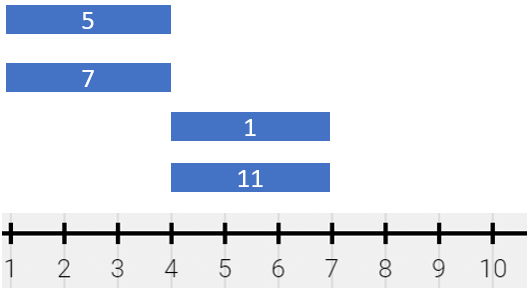Class Solution
java.lang.Object
g1901_2000.s1943_describe_the_painting.Solution
1943 - Describe the Painting\.
Medium
There is a long and thin painting that can be represented by a number line. The painting was painted with multiple overlapping segments where each segment was painted with a **unique** color. You are given a 2D integer array `segments`, where
segments[i] = [starti, endi, colori] represents the **half-closed segment** [starti, endi) with colori as the color.
The colors in the overlapping segments of the painting were **mixed** when it was painted. When two or more colors mix, they form a new color that can be represented as a **set** of mixed colors.
* For example, if colors `2`, `4`, and `6` are mixed, then the resulting mixed color is `{2,4,6}`.
For the sake of simplicity, you should only output the **sum** of the elements in the set rather than the full set.
You want to **describe** the painting with the **minimum** number of non-overlapping **half-closed segments** of these mixed colors. These segments can be represented by the 2D array `painting` where painting[j] = [leftj, rightj, mixj] describes a **half-closed segment** [leftj, rightj) with the mixed color **sum** of mixj.
* For example, the painting created with `segments = \[\[1,4,5],[1,7,7]]` can be described by `painting = \[\[1,4,12],[4,7,7]]` because:
* `[1,4)` is colored `{5,7}` (with a sum of `12`) from both the first and second segments.
* `[4,7)` is colored `{7}` from only the second segment.
Return _the 2D array_ `painting` _describing the finished painting (excluding any parts that are **not** painted). You may return the segments in **any order**_.
A **half-closed segment** `[a, b)` is the section of the number line between points `a` and `b` **including** point `a` and **not including** point `b`.
**Example 1:**

**Input:** segments = \[\[1,4,5],[4,7,7],[1,7,9]]
**Output:** [[1,4,14],[4,7,16]]
**Explanation:** The painting can be described as follows:
- [1,4) is colored {5,9} (with a sum of 14) from the first and third segments.
- [4,7) is colored {7,9} (with a sum of 16) from the second and third segments.
**Example 2:**

**Input:** segments = \[\[1,7,9],[6,8,15],[8,10,7]]
**Output:** [[1,6,9],[6,7,24],[7,8,15],[8,10,7]]
**Explanation:** The painting can be described as follows:
- [1,6) is colored 9 from the first segment.
- [6,7) is colored {9,15} (with a sum of 24) from the first and second segments.
- [7,8) is colored 15 from the second segment.
- [8,10) is colored 7 from the third segment.
**Example 3:**

**Input:** segments = \[\[1,4,5],[1,4,7],[4,7,1],[4,7,11]]
**Output:** [[1,4,12],[4,7,12]]
**Explanation:** The painting can be described as follows:
- [1,4) is colored {5,7} (with a sum of 12) from the first and second segments.
- [4,7) is colored {1,11} (with a sum of 12) from the third and fourth segments.
Note that returning a single segment [1,7) is incorrect because the mixed color sets are different.
**Constraints:**
* 1 <= segments.length <= 2 * 104
* `segments[i].length == 3`
* 1 <= starti < endi <= 105
* 1 <= colori <= 109
* Each colori is distinct.-
Constructor Summary
Constructors -
Method Summary
-
Constructor Details
-
Solution
public Solution()
-
-
Method Details
-
splitPainting
-